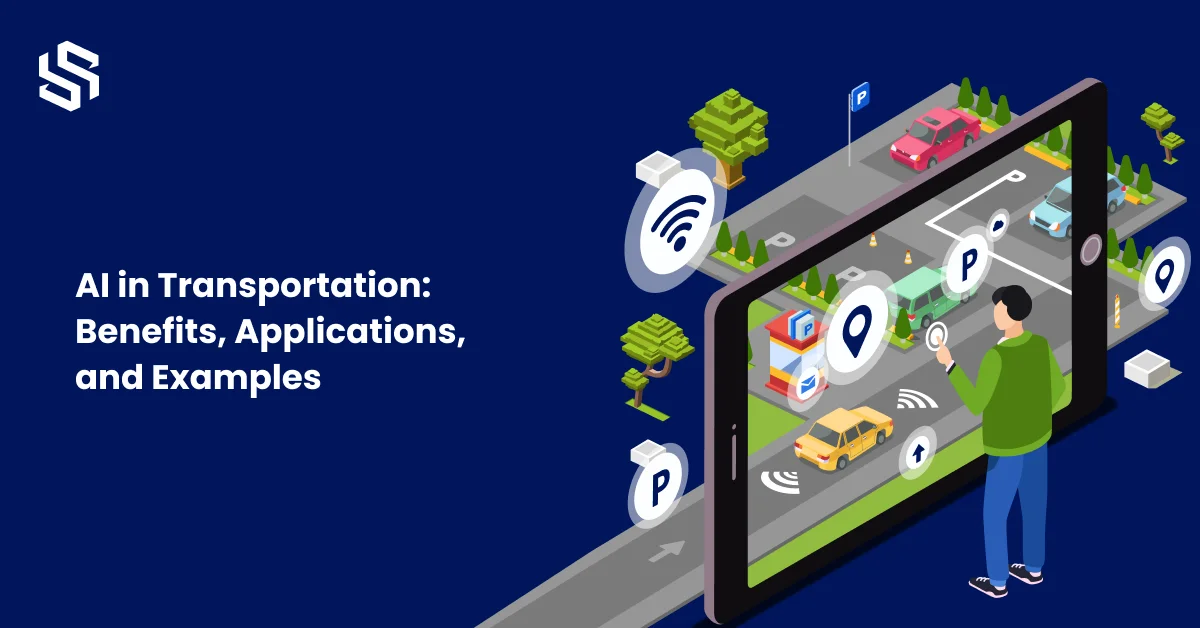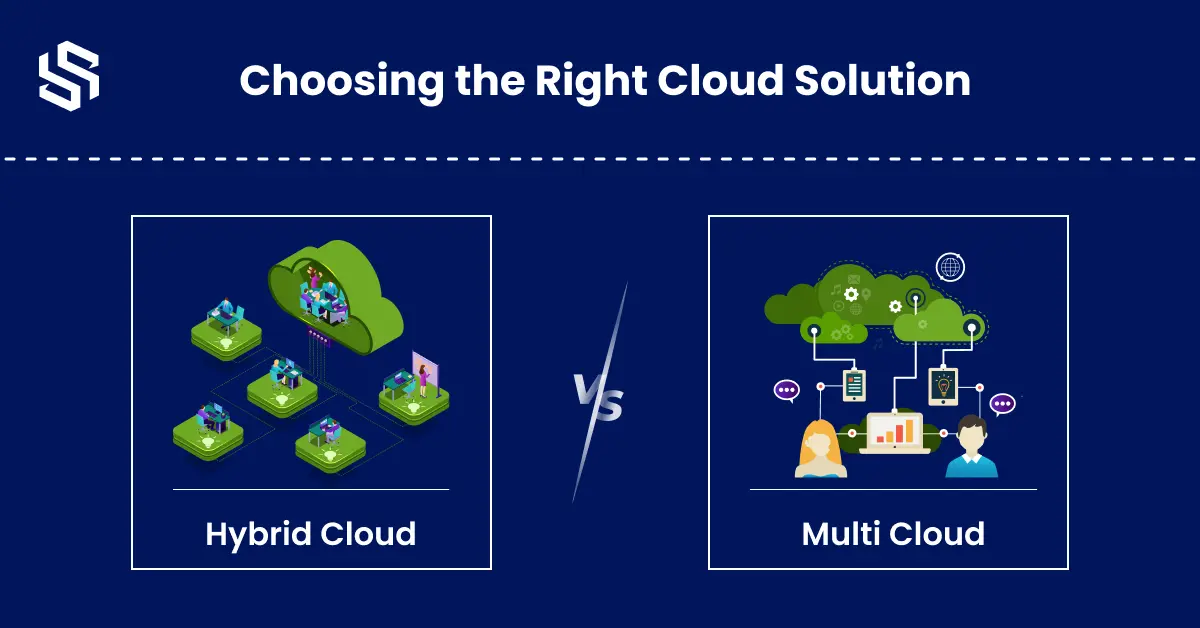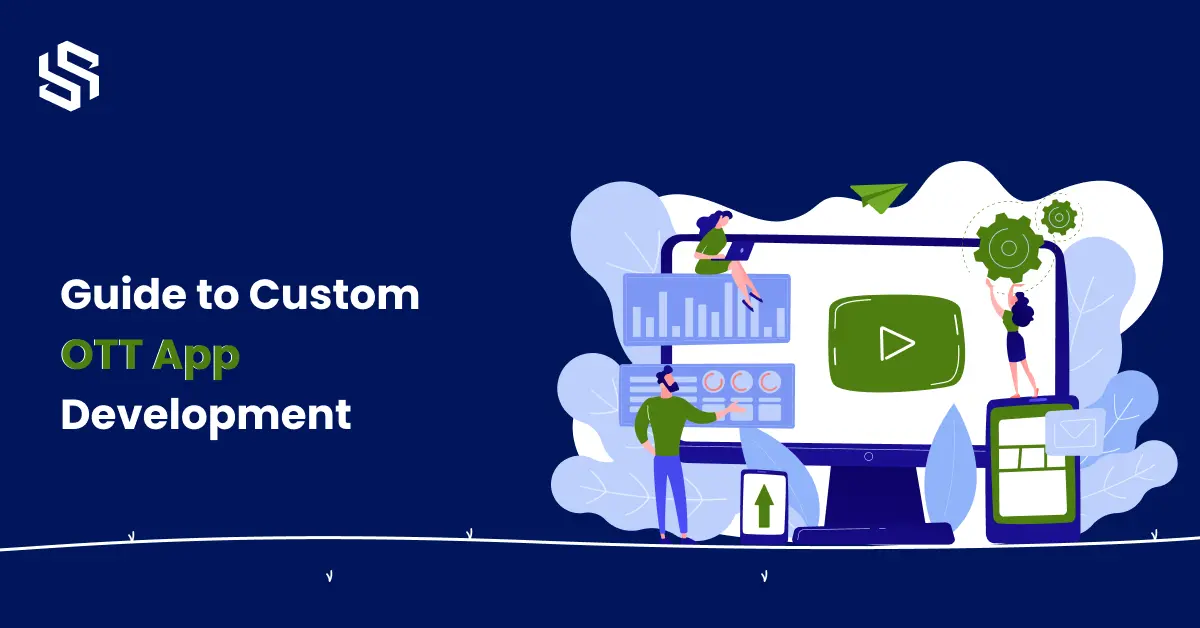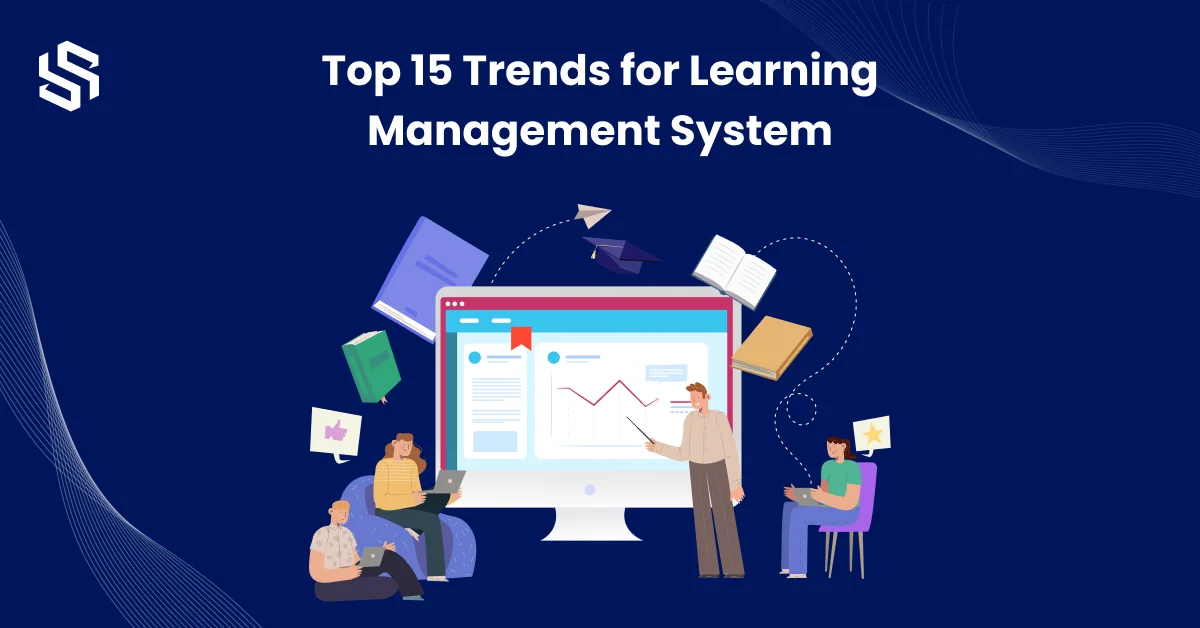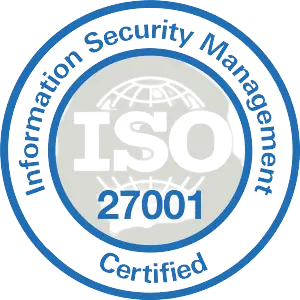Stuck in traffic again? Imagine a world where commutes are efficient, roads are decongested, and accidents become a thing of the past.
This isn’t science fiction – it’s the potential of Artificial Intelligence (AI) revolutionizing the transportation industry.
But how exactly is AI transforming the way we get around? What are the real-world benefits, and what does it all mean for the future?
Dive deeper into this blog post to explore the exciting possibilities of AI in transportation. We’ll delve into the benefits, uncover practical applications, and showcase real-world examples you might not even know about. Buckle up, and get ready for a ride into the future of mobility!
Importance of AI in revolutionizing the transportation industry
Transportation, the lifeblood of our world, faces significant challenges. According to a 2023 report by the World Bank, traffic congestion costs the global economy an estimated $1.9 trillion annually. Additionally, the World Health Organization (WHO) reports that road traffic crashes are the leading cause of death for young people aged 15-29 years old globally, claiming 1.3 million lives every year.
The Rise of AI as a Solution:
This is where Artificial Intelligence (AI) steps in, emerging as a powerful tool to revolutionize the transportation industry. AI, with its ability to analyze complex data, learn from patterns, and make real-time decisions, holds immense potential to improve efficiency, enhance safety, and optimize resource utilization across various transportation sectors.
The Transformative Power of AI:
From self-driving cars to intelligent traffic management systems, AI is weaving itself into the fabric of our transportation landscape, paving the way for a smarter, safer, and more sustainable future.
Here are some statistics highlighting the potential impact of AI in transportation:
The global AI in transportation market is expected to reach USD 23.11 billion by 2032, growing at a CAGR of 22.70% according to Precedence Research. This significant growth indicates the increasing adoption and investment in AI-powered transportation solutions.
A study by McKinsey & Company found that AI has the potential to reduce traffic congestion by up to 25% and improve overall transportation system efficiency by 20%. This translates to significant economic and environmental benefits.
A report by the National Highway Traffic Safety Administration (NHTSA) in the US suggests that self-driving cars, powered by AI, have the potential to reduce traffic fatalities by up to 90%. This holds immense promise for creating safer roads and saving lives.
These statistics showcase the transformative power of AI in addressing critical transportation challenges and shaping a future of mobility that is efficient, safe, and sustainable.
Check Out Our Success Story of Transportation Tracking Software
Interested in learning more about AI’s impact on transportation?
Request a free quote for our insightful blog post on harnessing AI for transportation.
Understanding AI in Transportation
Defining AI and its Relevance:
Before diving deeper, let’s establish a common ground. Artificial intelligence (AI) refers to the development of intelligent systems that can mimic human cognitive functions such as learning, reasoning, and problem-solving.
In the context of transportation, AI becomes a game-changer by analyzing vast amounts of data generated from various sources, including:
- Traffic sensors
- GPS data
- Weather information
- Vehicle performance data
- Public transportation schedules
The AI Evolution in Transportation:
The integration of AI in transportation has been an evolving journey. Initially, it began with basic applications like route optimization for delivery trucks. As technology advanced, AI found its way into traffic management systems, enabling real-time signal adjustments and congestion prediction. Today, we stand at the forefront of a revolution, witnessing the potential of autonomous vehicles powered by sophisticated AI algorithms.
Key Technologies Driving the AI Revolution:
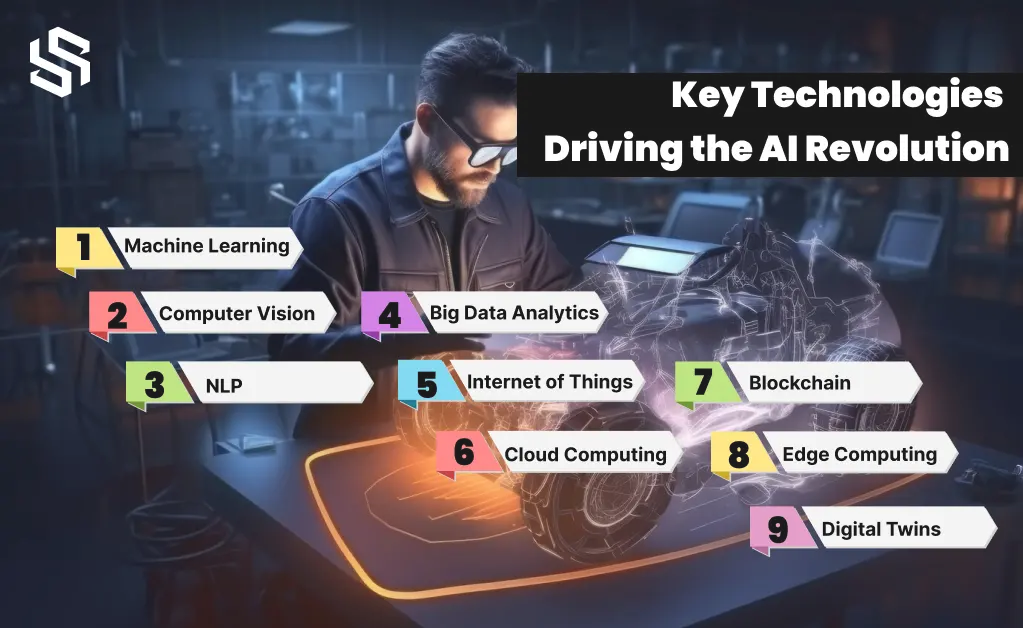
Several key technologies underpin the power of AI in transportation:
Machine Learning:
This allows AI systems to learn from data without explicit programming, enabling them to continuously improve their performance over time.
Computer Vision:
This technology enables AI systems to “see” and understand the world around them through cameras and sensors, crucial for tasks like object detection, lane identification, and obstacle avoidance in autonomous vehicles.
Natural Language Processing (NLP):
This allows AI systems to understand and respond to human language, paving the way for intelligent chatbots in customer service or voice-activated navigation systems.
Big Data Analytics:
Processing and analyzing massive datasets is crucial for AI to identify complex patterns and make informed decisions in transportation systems.
The Internet of Things (IoT):
Connecting various transportation components (vehicles, traffic lights, infrastructure) through the IoT allows for real-time data exchange and facilitates AI-powered decision-making.
Cloud Computing:
The ability to access and process massive amounts of data on the cloud is essential for scaling AI applications across the transportation landscape.
- Blockchain: This technology, known for its secure data sharing and record-keeping capabilities, has the potential to revolutionize how transportation data is managed and accessed, fostering trust and transparency in connected transportation ecosystems.
- Edge Computing: Processing data closer to its source, at the “edge” of the network, can improve response times and decision-making for AI applications in real-time scenarios like autonomous vehicle control.
- Digital Twins: Creating virtual replicas of physical transportation systems allows for AI-powered simulations and testing, optimizing operations and improving safety before real-world implementation.
Read More About Is Technology Revolutionizing or Hindering the Tourism Industry?
Benefits of AI in Transportation
AI’s integration into the transportation sector promises a multitude of benefits, transforming how we move people and goods:
1. Enhanced Safety and Security Measures:
- Autonomous vehicles equipped with AI and advanced sensors have the potential to significantly reduce accidents caused by human error, such as drunk driving, fatigue, and distracted driving.
- AI-powered traffic management systems can optimize traffic flow, reducing congestion and the associated risks of accidents.
- Predictive maintenance enabled by AI can identify potential vehicle issues before they occur, preventing breakdowns and improving overall safety on the roads.
2. Optimization of Transportation Systems and Routes:
- AI-powered route optimization for delivery trucks and public transportation can minimize travel times and fuel consumption, increasing efficiency and reducing costs.
- Real-time traffic signal adjustments based on AI analysis can improve traffic flow, reducing congestion and wait times for commuters.
- Dynamic ride-sharing platforms powered by AI can match riders with drivers more efficiently, reducing empty vehicle miles and optimizing resource utilization.
3. Reduction of Carbon Footprint through Efficient Resource Management:
- AI-powered route optimization for vehicles reduces travel distances and fuel consumption, leading to lower CO2 emissions and a smaller environmental footprint.
- Traffic management systems that optimize traffic flow can reduce idling times and associated emissions.
- Electric vehicles integrated with AI for battery management and charging optimization can further contribute to a cleaner and more sustainable transportation system.
4. Improvement in Operational Efficiency and Cost-Effectiveness:
- Predictive maintenance powered by AI can minimize downtime for vehicles, leading to increased operational efficiency for transportation companies.
- AI-powered logistics and fleet management can optimize resource allocation, reducing operational costs and improving profitability.
- Autonomous vehicles have the potential to reduce labor costs associated with human drivers, although ethical considerations and regulations need careful attention.
Overall, AI offers a promising path towards a safer, more efficient, and sustainable transportation future. However, it’s crucial to address concerns regarding ethical considerations, data privacy, and potential job displacement as AI continues to reshape the transportation landscape.
Read More About Breaking Barriers: Overcoming Language and Cultural Differences through Travel App Development
Applications of AI in Transportation
AI is rapidly transforming various aspects of transportation, giving rise to exciting and innovative applications:
1. Autonomous Vehicles: Advancements and Challenges:
Self-driving cars equipped with AI and advanced sensors like LiDAR, cameras, and radar are being actively developed and tested by tech giants and car manufacturers.
These vehicles hold the potential to revolutionize transportation by offering increased safety, improved accessibility for the elderly or disabled, and reduced traffic congestion.
However, challenges remain, including the need for robust sensor technology that can handle diverse weather conditions and complex driving scenarios, clear and consistent regulations across different regions, and addressing ethical concerns surrounding decision-making in critical situations like accidents or avoiding pedestrians.
2. Traffic Management and Congestion Prediction:
AI-powered traffic management systems analyze data from sensors, cameras, connected vehicles, and even social media sentiment analysis to predict traffic patterns, optimize signal timings, and dynamically adjust lane usage based on real-time demand.
This can reduce congestion, improve travel times, and minimize fuel consumption.
Additionally, AI can predict and respond to real-time incidents like accidents or road closures, further enhancing traffic flow management.
Cities around the world are implementing these systems, with Singapore and Amsterdam being notable examples.
3. Predictive Maintenance for Vehicles and Infrastructure:
AI algorithms can analyze sensor data from vehicles (engine performance, tire pressure, etc.) and infrastructure (bridge health, track wear, etc.) to predict potential maintenance needs before they lead to breakdowns or failures.
This proactive approach can improve safety, reduce downtime, and optimize maintenance scheduling.
For example, AI can monitor engine performance data to predict component failure and schedule preventive maintenance, preventing major breakdowns and accidents.
Additionally, AI can be used to optimize maintenance routes for technicians, saving time and resources.
4. Smart Logistics and Supply Chain Management:
AI is revolutionizing logistics and supply chains by optimizing routes, scheduling deliveries, managing inventory, and even predicting demand.
AI-powered algorithms can analyze vast amounts of data, including traffic conditions, weather, fuel consumption, historical data, and even social media trends, to find the most efficient routes for delivery trucks, trains, and airplanes.
This not only reduces costs but also minimizes the environmental impact of transportation by optimizing resource utilization.
Companies like Amazon and FedEx are heavily invested in AI-powered logistics solutions.
5. Personalized Travel Experiences and Services:
AI is increasingly used to personalize travel experiences for passengers, making journeys smoother and more convenient.
AI-powered chatbots can provide real-time information and assistance to travelers, from booking tickets and navigating airports to recommending tourist attractions and suggesting alternative travel options.
Additionally, AI can personalize public transportation information by displaying real-time arrival and departure times, suggesting alternative routes based on user preferences and real-time conditions, and recommending nearby points of interest.
Mobile apps powered by AI can also help travelers navigate unfamiliar cities, translate languages in real-time, and find nearby restaurants or attractions based on their preferences.
Beyond these core applications, AI is also being explored in various other areas of transportation, including:
- Drone delivery: AI-powered drones are being tested for delivering goods in urban and rural areas, potentially revolutionizing last-mile delivery.
- Advanced air mobility: AI is being explored for managing air taxis and other futuristic flying vehicles, aiming to create a safe and efficient urban air transportation system.
- Personalized insurance: AI can analyze driving behavior and other data to provide personalized insurance quotes and incentivize safer driving habits.
- Autonomous public transportation: Self-driving buses and trams are being piloted in various cities, offering new possibilities for public transportation in the future.
These are just a few examples of how AI is transforming the transportation landscape. As AI technology continues to evolve, we can expect even more innovative applications to emerge, shaping the future of how we move people and goods in a safer, smarter, and more sustainable way.
Features and Processes
The successful implementation of AI in transportation relies on several key features and processes:
1. Data Collection and Analysis for AI Applications:
Massive amounts of data are the fuel for AI in transportation. This data comes from various sources, including:
- Traffic sensors: These capture real-time data on traffic flow, speed, and congestion.
- GPS data: Provides information on vehicle location, speed, and travel times. It is projected that by 2025, there will be over 400 million connected cars in operation, up from some 237 million in 2021.
- Weather information: Real-time and historical weather data helps AI predict how weather events might impact traffic patterns.
- Vehicle performance data: On-board sensors collect data on fuel efficiency, engine health, and potential maintenance needs.
- Public transportation schedules: Integrating existing schedules with real-time data allows for optimized route planning and passenger wait times.
- Social media sentiment analysis: Gauging public perception of traffic conditions and disruptions can inform AI-powered traffic management strategies.
- High-definition (HD) maps: Detailed maps with lane markings, traffic signals, and points of interest provide crucial context for autonomous vehicles and other AI applications.
- Historical accident data: Analyzing past accidents helps AI identify accident-prone areas and develop preventative measures. According to the World Health Organization, an estimated 1.3 million people die each year on the world’s roads.
- Demographic data: Understanding population distribution and travel patterns allows for targeted transportation planning and resource allocation. In 2024, the global urban population is estimated to be 56.4%, according to the United Nations, highlighting the increasing need for efficient transportation solutions in urban areas.
2. Integration of AI with IoT Devices and Sensors:
The Internet of Things (IoT) plays a crucial role in connecting various transportation components, such as vehicles, traffic lights, and infrastructure.
Sensors embedded in these components collect real-time data on various parameters like traffic flow, weather conditions, and vehicle performance.
This data is then fed into AI algorithms for real-time analysis and decision-making.
For example, AI can analyze data from traffic sensors to adjust traffic signals dynamically, optimizing traffic flow and reducing congestion.
3. Real-time Decision-making Algorithms for Transportation Systems:
AI algorithms are designed to analyze data and make decisions in real-time. This is crucial for applications like:
- Autonomous vehicles: AI needs to make quick decisions based on sensor data to navigate safely and respond to unexpected situations.
- Traffic management systems: AI can adjust signal timings and lane usage in real-time based on changing traffic conditions.
- Predictive maintenance: AI can analyze sensor data from vehicles and infrastructure to identify potential problems and trigger preventive maintenance measures before breakdowns occur.
4. Regulatory Considerations and Ethical Implications:
The integration of AI into transportation raises important regulatory considerations:
- Safety standards: Robust regulations are needed to ensure the safety and reliability of AI-powered systems, especially in autonomous vehicles.
- Data privacy: Protecting user privacy and ensuring responsible data collection and usage is crucial.
- Bias and fairness: AI algorithms can perpetuate existing societal biases, and it’s essential to develop and implement fair and ethical AI systems in transportation.
Ethical questions also need careful consideration:
- Who is responsible for accidents involving autonomous vehicles?
- How will AI-powered transportation systems impact job displacement in the transportation sector?
- How can we ensure equitable access to AI-powered transportation benefits for all members of society?
Addressing these challenges is crucial for ensuring the responsible and ethical development and deployment of AI in transportation.
Explore our comprehensive range of AI services tailored for the transportation industry.
From predictive maintenance to route optimization, discover how we can enhance your operations.
Do’s and Don’ts of Implementing AI in Transportation
Successfully navigating the exciting world of AI in transportation requires careful consideration of both opportunities and challenges. Here’s a roadmap to guide responsible implementation:
Do’s:
- Invest in robust data infrastructure and security measures:
Building a solid foundation for data collection, storage, and analysis is essential.
Invest in secure data infrastructure, implement strong cybersecurity protocols, and ensure data privacy compliance.
- Collaborate with industry stakeholders for seamless integration:
Transportation is a complex ecosystem.
Collaborate with policymakers, car manufacturers, infrastructure providers, and public transportation agencies to ensure smooth integration of AI across the entire system.
- Prioritize transparency and explainability in AI decision-making:
Users need to understand how AI-powered systems make decisions, especially in critical areas like autonomous vehicles.
Strive for transparency in algorithms and explainability in their decisions.
- Focus on continuous learning and improvement:
AI is constantly evolving.
Implement processes for continuous learning and improvement of AI algorithms, ensuring they adapt to changing data patterns and real-world scenarios.
Don’ts:
- Overlook the importance of human oversight and intervention:
While AI holds immense potential, it’s not a replacement for human expertise and judgment.
Maintain clear lines of human oversight and intervention, especially in critical decision-making processes.
- Underestimate the challenges and risks associated with AI implementation:
Be aware of the potential challenges, including ethical concerns, data bias, and safety risks.
Proactively address these challenges through responsible development, testing, and implementation practices.
- Rush into deployment without proper planning and testing:
Thoroughly test and evaluate AI systems in controlled environments before large-scale deployment.
Ensure they meet safety standards and address potential risks before real-world integration.
- Neglect the human factor in the transition to AI-powered transportation:
The transition to AI-powered transportation should be mindful of its impact on the workforce.
Develop strategies for reskilling and upskilling individuals potentially affected by job displacement due to automation.
By adhering to these “do’s and don’ts,” we can unlock the immense potential of AI in transportation while remaining mindful of the ethical and societal considerations crucial for a sustainable and responsible future.
Ready to optimize your transportation systems with AI?
Hire our dedicated AI developers and unlock the full potential of intelligent transportation solutions.
Real-life Examples: AI Shaping the Transportation Landscape
AI is no longer a futuristic concept in transportation – it’s a tangible reality shaping our daily lives. Here are some real-world examples showcasing its transformative power:
1. Tesla’s Autopilot and Full Self-Driving Capabilities:
Tesla’s Autopilot and Full Self-Driving (FSD) features utilize a combination of cameras, radar, and ultrasonic sensors to provide varying levels of driver assistance, from lane-keeping and adaptive cruise control to navigating highways and city streets (with constant driver supervision emphasized).
While not fully autonomous yet, these features demonstrate the advancements in AI-powered driver assistance systems, paving the way for potential future applications.
2. Uber’s AI-driven Predictive Demand Forecasting:
Uber leverages AI to predict demand for rides in different areas at specific times.
This allows them to dynamically adjust pricing and optimize driver allocation, ensuring riders get prompt service and drivers experience efficient utilization of their time.
This AI-powered system contributes to a smoother and more efficient ride-hailing experience for both riders and drivers.
3. Waymo’s Autonomous Driving Technology in Commercial Applications:
Waymo, a self-driving car company owned by Alphabet (Google’s parent company), has launched commercial self-driving taxi services in limited areas like Phoenix, Arizona, and San Francisco, California.
These vehicles use a suite of AI algorithms and advanced sensors to navigate streets, recognize objects, and make decisions in real time.
While still in its early stages, Waymo’s commercial launch marks a significant step towards the potential future of autonomous vehicles integrated into transportation systems.
4. Maersk’s Use of AI for Optimizing Shipping Routes and Logistics:
Maersk, a leading shipping company, utilizes AI to optimize shipping routes and manage logistics across its global operations.
AI algorithms analyze various factors like weather conditions, fuel consumption, and port congestion to find the most efficient routes for cargo ships, reducing fuel costs and emissions.
Additionally, AI helps Maersk predict potential delays and streamline logistics, ensuring smoother and more efficient international shipping operations.
Check Out Our Success Story of Fleet Management Software
Future Outlook and Conclusion: AI’s Transformative Journey in Transportation
Looking ahead, the future of AI in transportation promises exciting advancements and groundbreaking innovations:
Potential Advancements and Innovations:
- Fully autonomous vehicles: Continued advancements in AI, sensor technology, and regulations could pave the way for widespread adoption of fully autonomous vehicles in the coming years, revolutionizing personal and public transportation.
- Hyperloop and flying taxis: Emerging transportation solutions like Hyperloop and flying taxis are actively exploring AI integration for autonomous navigation and fleet management.
- Personalized and multimodal transportation: AI-powered platforms could offer personalized journey recommendations that seamlessly combine different transportation modes (e.g., trains, buses, bikes) for optimal efficiency and convenience.
- Predictive maintenance for infrastructure: AI could play a crucial role in predicting and preventing infrastructure failures such as bridge collapses or railway track issues, enhancing safety and minimizing disruptions.
- Sustainable transportation solutions: AI can be harnessed to optimize traffic flow, improve energy efficiency for vehicles and infrastructure, and promote the adoption of sustainable transportation options like electric vehicles and public transportation.
Importance of Continued Research and Development:
As with any emerging technology, continuous research and development (R&D) are crucial for the responsible and sustainable advancement of AI in transportation. Key areas of focus include:
- Safety and reliability: Ensuring the safety and reliability of AI-powered systems, especially in autonomous vehicles, is paramount. Rigorous testing, clear regulations, and human oversight are essential elements.
- Data privacy and security: Robust data security measures and ethical data handling practices are crucial to protect user privacy and build trust in AI-powered transportation systems.
- Addressing ethical concerns: Proactive efforts are required to address ethical concerns like potential job displacement, bias in algorithms, and equitable access to AI-powered transportation benefits for all.
Summary and Transformative Impact:
In conclusion, AI is not just shaping the future of transportation – it’s actively transforming it. By harnessing the power of AI, we can unlock a world of possibilities, from safer roads and more efficient travel to sustainable practices and a future of transportation that benefits all.
Key Takeaways:
- AI offers immense potential to improve safety, efficiency, and sustainability in transportation.
- Successful implementation requires a multifaceted approach addressing data, technology, regulations, and ethical considerations.
- Continued research, development, and collaboration are crucial for navigating the ethical and societal implications of AI in transportation.
As we continue to explore the potential of AI, one thing is certain: the journey towards a smarter, safer, and more sustainable transportation future is driven by innovation, collaboration, and a commitment to responsible development.
Have questions or need assistance with AI integration in transportation?
Contact us today for personalized support and expert guidance.
As we look ahead, it’s crucial to recognize the role of companies like Syndell, an AI development company, in shaping this transformative journey. Syndell is committed to pioneering advancements in AI technology and leveraging its potential to drive positive change in the transportation sector. By harnessing the power of AI, Syndell empowers businesses to embrace innovation, optimize their operations, and create a more efficient and sustainable transportation ecosystem.
Ready to embark on your AI development journey? Contact Syndell today to get started with your AI development services. Whether you’re looking to integrate AI solutions into your transportation systems or hire dedicated AI/ML developers, Syndell provides tailored solutions to meet your unique needs. Get a free quote and take the first step towards unlocking the full potential of AI in transportation.
FAQs
1. Is AI safe for self-driving cars?
Safety remains a primary concern with self-driving cars. While AI has the potential to significantly reduce accidents caused by human error, rigorous testing, regulations, and clear lines of responsibility are crucial.
2. Will AI take away my job in transportation?
AI automation may impact certain transportation jobs like truck drivers or taxi drivers. However, new opportunities will likely emerge in areas like AI development, maintenance of autonomous vehicles, and data analysis for transportation systems. Reskilling initiatives will be crucial to ensure a smooth transition.
3. How will AI impact the environment in transportation?
4. How will AI be used in public transportation?
AI can optimize public transportation routes and schedules based on real-time data, improving efficiency and reducing wait times. Additionally, AI can be used for predictive maintenance of public transport infrastructure to prevent disruptions.

